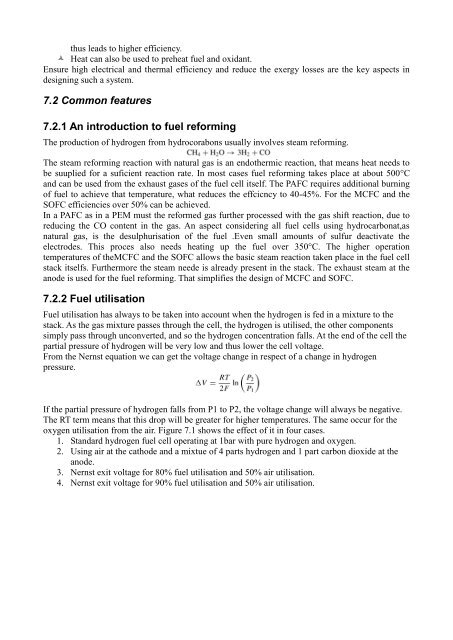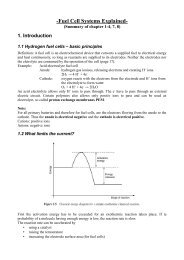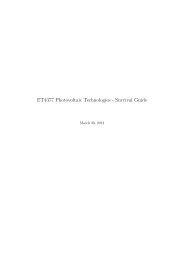Fuel Cell Systems Explained - from and for SET students
Fuel Cell Systems Explained - from and for SET students
Fuel Cell Systems Explained - from and for SET students
Create successful ePaper yourself
Turn your PDF publications into a flip-book with our unique Google optimized e-Paper software.
thus leads to higher efficiency. Heat can also be used to preheat fuel <strong>and</strong> oxidant.Ensure high electrical <strong>and</strong> thermal efficiency <strong>and</strong> reduce the exergy losses are the key aspects indesigning such a system.7.2 Common features7.2.1 An introduction to fuel re<strong>for</strong>mingThe production of hydrogen <strong>from</strong> hydrocorabons usually involves steam re<strong>for</strong>ming.The steam re<strong>for</strong>ming reaction with natural gas is an endothermic reaction, that means heat needs tobe suuplied <strong>for</strong> a suficient reaction rate. In most cases fuel re<strong>for</strong>ming takes place at about 500°C<strong>and</strong> can be used <strong>from</strong> the exhaust gases of the fuel cell itself. The PAFC requires additional burningof fuel to achieve that temperature, what reduces the effcicncy to 40-45%. For the MCFC <strong>and</strong> theSOFC efficiencies over 50% can be achieved.In a PAFC as in a PEM must the re<strong>for</strong>med gas further processed with the gas shift reaction, due toreducing the CO content in the gas. An aspect considering all fuel cells using hydrocarbonat,asnatural gas, is the desulphurisation of the fuel .Even small amounts of sulfur deactivate theelectrodes. This proces also needs heating up the fuel over 350°C. The higher operationtemperatures of theMCFC <strong>and</strong> the SOFC allows the basic steam reaction taken place in the fuel cellstack itselfs. Furthermore the steam neede is already present in the stack. The exhaust steam at theanode is used <strong>for</strong> the fuel re<strong>for</strong>ming. That simplifies the design of MCFC <strong>and</strong> SOFC.7.2.2 <strong>Fuel</strong> utilisation<strong>Fuel</strong> utilisation has always to be taken into account when the hydrogen is fed in a mixture to thestack. As the gas mixture passes through the cell, the hydrogen is utilised, the other componentssimply pass through unconverted, <strong>and</strong> so the hydrogen concentration falls. At the end of the cell thepartial pressure of hydrogen will be very low <strong>and</strong> thus lower the cell voltage.From the Nernst equation we can get the voltage change in respect of a change in hydrogenpressure.If the partial pressure of hydrogen falls <strong>from</strong> P1 to P2, the voltage change will always be negative.The RT term means that this drop will be greater <strong>for</strong> higher temperatures. The same occur <strong>for</strong> theoxygen utilisation <strong>from</strong> the air. Figure 7.1 shows the effect of it in four cases.1. St<strong>and</strong>ard hydrogen fuel cell operating at 1bar with pure hydrogen <strong>and</strong> oxygen.2. Using air at the cathode <strong>and</strong> a mixtue of 4 parts hydrogen <strong>and</strong> 1 part carbon dioxide at theanode.3. Nernst exit voltage <strong>for</strong> 80% fuel utilisation <strong>and</strong> 50% air utilisation.4. Nernst exit voltage <strong>for</strong> 90% fuel utilisation <strong>and</strong> 50% air utilisation.






